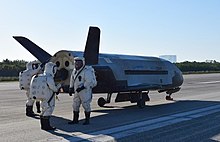X-37B_OTV4_landed_at_Kennedy_Space_Center_(170507-O-FH989-001).jpg

Part 2 of 3 Parts (Please read Part 1 first)
These specifications are taken from official numbers and other figures that are publicly available.
• Length: 29 feet 3 inches
• Wingspan: 14 feet 11 inches
• Height: 9 feet 6 inches
• Payload bay: 7 feet × 4 feet
• Payload capacity: 500 pounds
• Max launch weight: 11,000 pounds
• Crew: None/Autonomous
• Electrical power: Gallium arsenide solar cells with lithium-ion batteries
• Launch vehicles: United Launch Alliance Atlas V (501) and SpaceX Falcon 9
• Orbital speed: 17,426 miles per hour
• Orbit: Low Earth orbit
The X-37B has flown six missions. However, its true purpose has not been revealed to the public. The Space Force’s latest Orbital Test Vehicle drone has raised suspicion both at home and abroad with regard to its actual purpose. There has been speculation that it may be a space-based anti-satellite strike aircraft. Or it could be used for high-altitude surveillance and the deployment of spy satellites. Perhaps it could be used to track enemy weapons or missiles launches.
According to the Pentagon, the X-37B was recently fitted with a new service module. This new module allows for a great number of experiments to be carried to orbit. During a mission in 2020, the X-37B deployed a small satellite called FalconSt-8. This satellite contained five experimental payloads designed by NASA and the U.S. Air Force. This was the first time that the U.S. military disclosed any specifics about payloads.
An Air Force report revealed that the program is testing advanced guidance, navigation, and control, avionics, thermal protection systems, conformal reusable insulation, lightweight electromechanical flight systems, advanced propulsion systems, advanced materials, and autonomous orbital flight, reentry, and landing technologies.
The Air Force’s list of stated technologies being tested raises many intriguing and important issues. Many of these have to do with the capability of carrying out activities at extremely high speeds and high temperatures. In 2019, former Air Force Secretary Heather Wilson told a panel at the Aspen Security Forum that the X-37B may be able to fly low enough to make use of the Earth’s atmosphere to alter its orbit. Such maneuvers may be designed to prevent enemies from predicting exactly how the craft will move.
The ability to maintain a steady flight trajectory for space traveling weapons such as intercontinental ballistic missiles or hypersonic missiles also makes thermal protection critical for space flight in several fundamental ways.
In order for humans to travel in space, they must have thermal protection technology. It is possible that some time in the future, human, armed, high-speed spacecraft could launch attacks from beyond the atmosphere of the Earth.
These materials are already undergoing rapid development because they are essential for the operational deployment of hypersonic weapons. They are required to ensure that the structural configurations required to produce the right air flow boundary layer surrounding missiles, interceptors, or spacecraft, in addition to maintain the stability of flight at hypersonic speed.
Please read Part 3 next